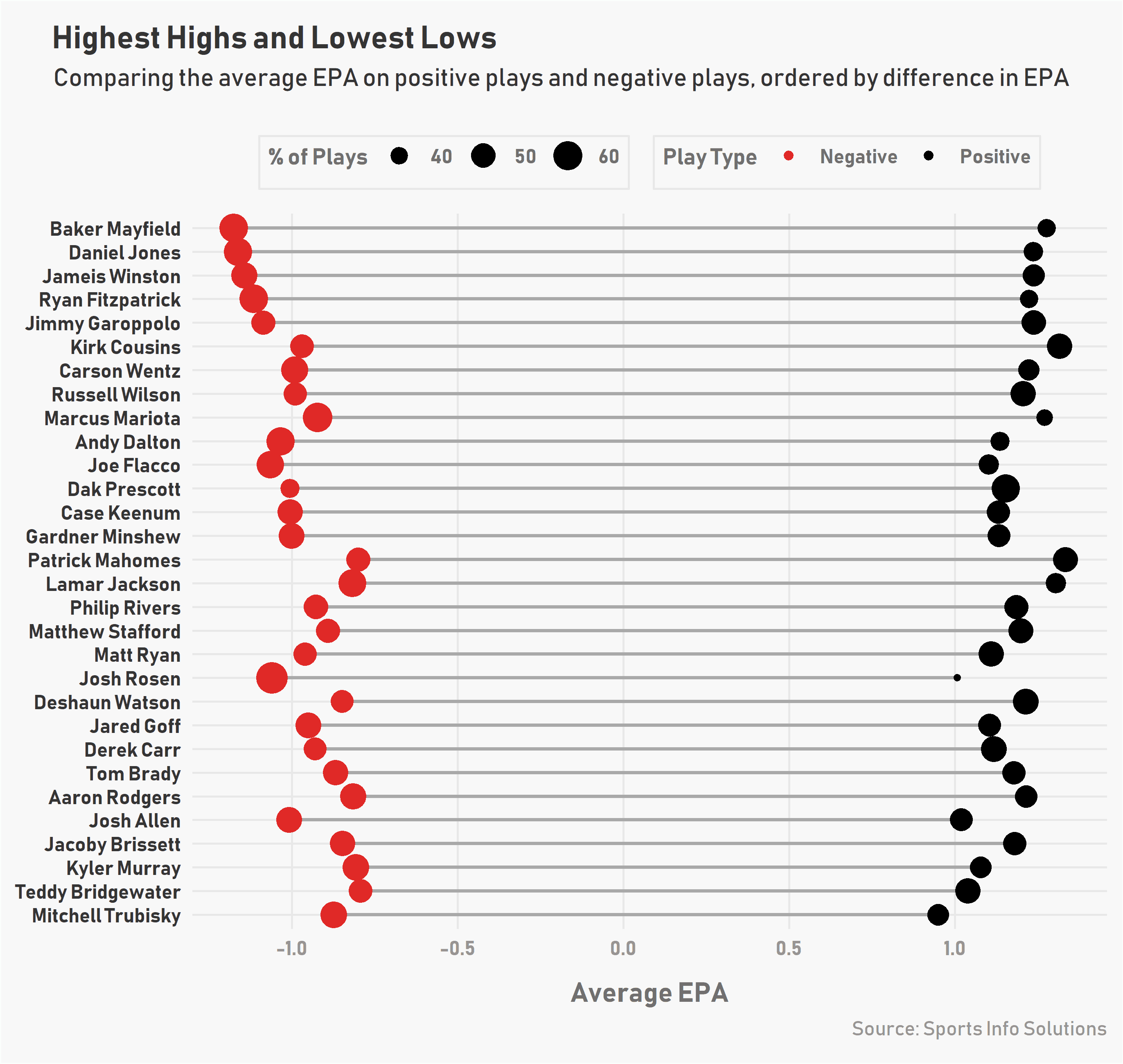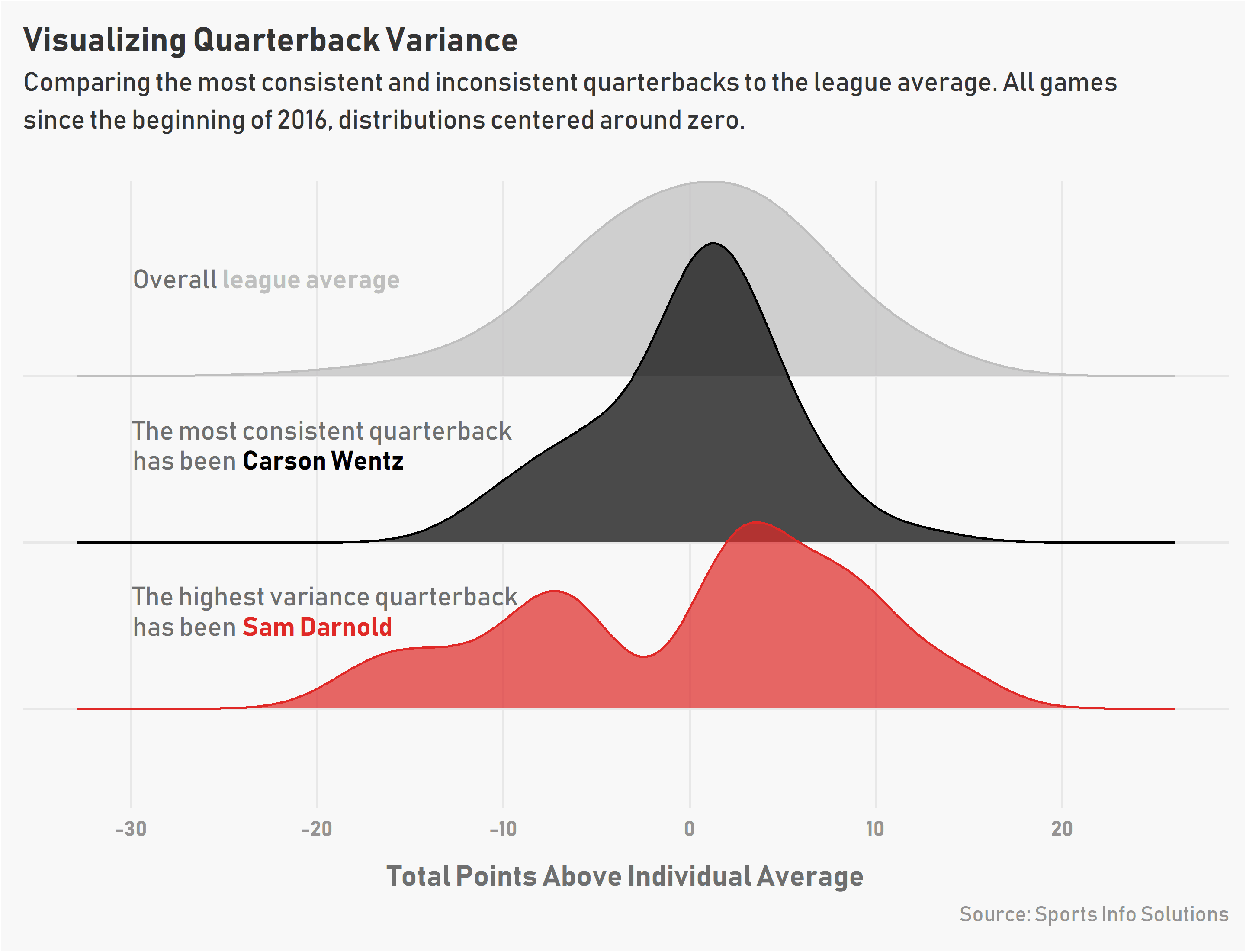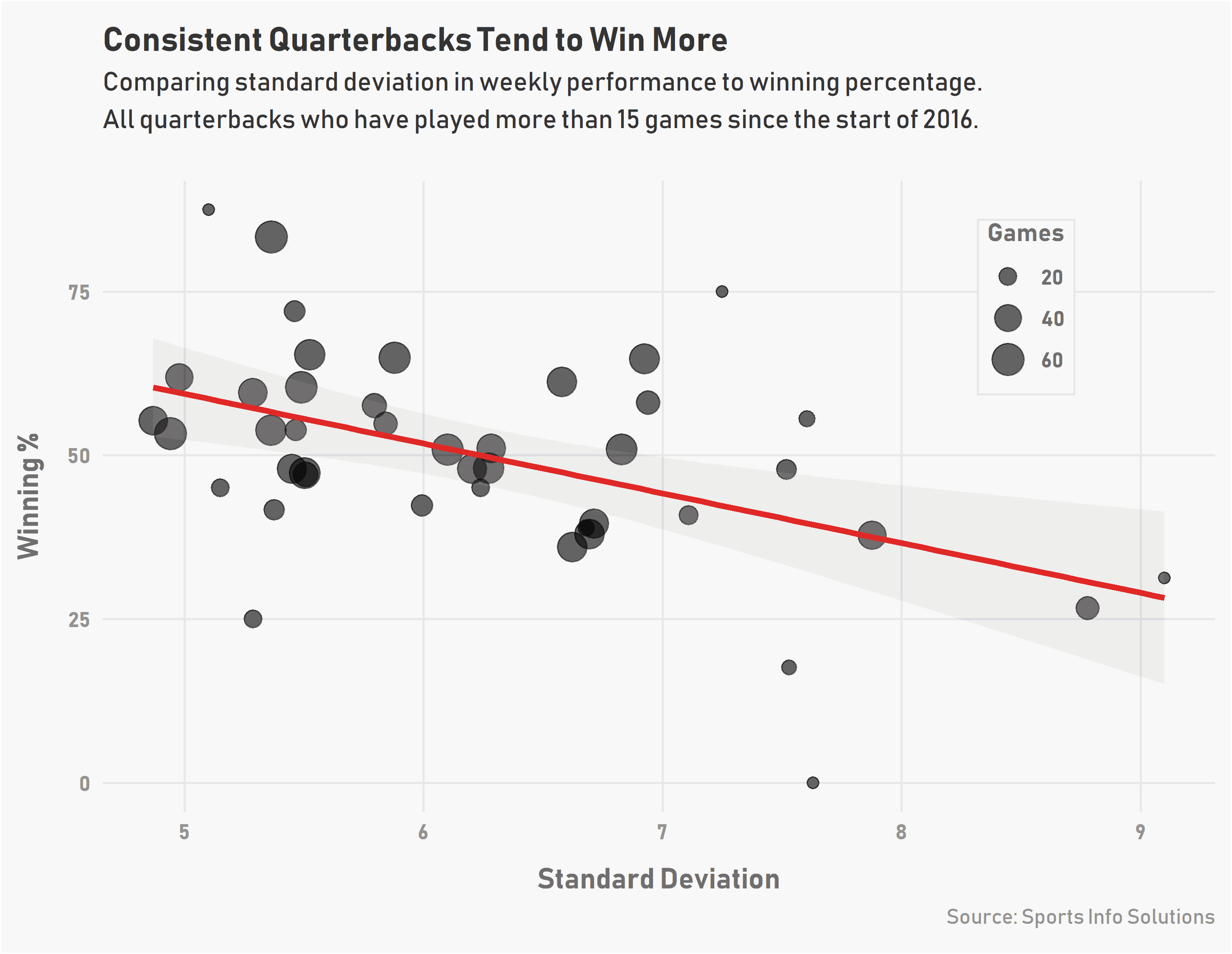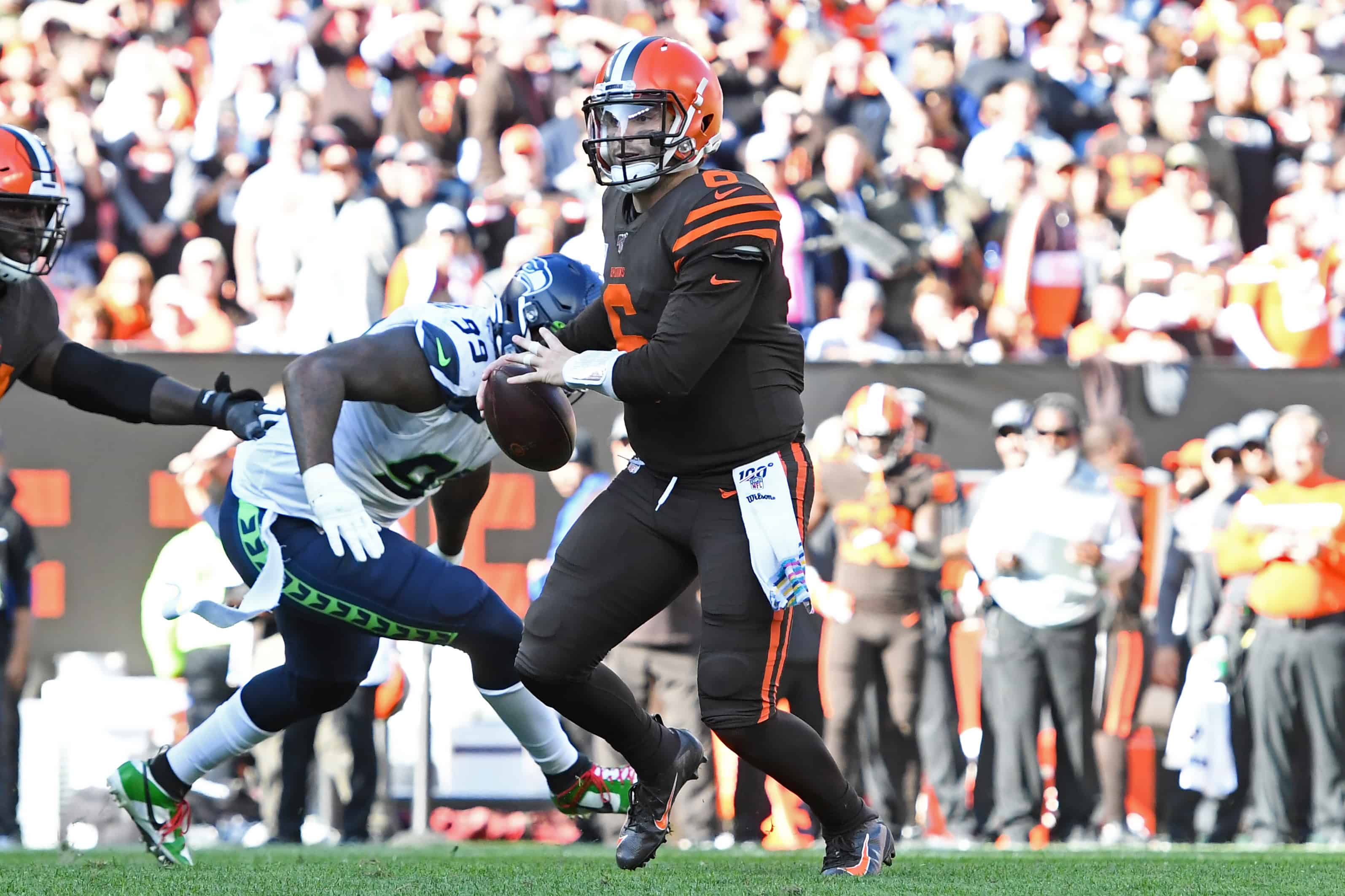One of the early stories of 2019 has been the inconsistent play of young quarterbacks. After bursting onto the scene in record-breaking fashion last season, Baker Mayfield looked like the quarterback Cleveland Browns fans have spent the last two decades waiting for. Instead, Mayfield and the Browns have limped out of the gate to a 2-4 record.
New York Giants GM Dave Gettleman was briefly vindicated in Week 3, only to see Daniel Jones come crashing back down to Earth in the weeks since. Only one year removed from a 12-4 record and a playoff appearance, Mitchell Trubisky has been hit hard by regression and has struggled to find any amount of success.
The list goes on, but the point is that it's been hard to make a lot of sense of what we’ve seen from these quarterbacks so far.
Variance on a Play Level
When it comes to young quarterbacks, inconsistent play comes with the territory. What most coaches are hoping for is flashes of upside while limiting the truly disastrous plays. To get a sense for which players are doing this, we can compare the difference in Expected Points Added per Dropback (EPA/D) on positive plays (EPA > 0) and negative plays (EPA < 0). In essence, when he’s good, how good is he, and when he’s bad, how bad is he.

So far in 2019, the most all-or-nothing quarterback at the play level is the aforementioned Mayfield. Mayfield’s EPA/D of minus-1.17 on negative plays is the worst in the league, while his EPA/D of 1.28 on positive plays is the fourth highest. Mayfield had a similar albeit less extreme split in 2018, but the real difference was he had fewer negative plays last year. His style of play hasn’t really changed much; he’s just not executing at the same level he was a year ago.
Just behind Mayfield is polarizing rookie Daniel Jones. After earning the nickname of “Danny Dimes” with his stunning debut in Week 3, Jones’s Independent Quarterback Rating of 75.0 ranks 27th of 31 qualifying quarterbacks, and his minus-9 Points Earned ranks dead last. Jones is also the only quarterback to throw more interceptions than Mayfield in that time period.
Like Mayfield, Jones has flashed some big-play ability — his EPA/D on positive plays ranks as the eighth-best in the league — but when it’s gone wrong, it’s gone really wrong. His EPA/D of minus-1.16 on negative plays is only narrowly better than Mayfield.
The players at the other end are largely unsurprising. The Saints have been very careful with Teddy Bridgewater since he took over for the injured Drew Brees, and to Bridgewater’s credit, he has done a great job executing. There haven't been a lot of big plays, but he’s made very few costly mistakes. His EPA/D on negative plays is the lowest in the league.
Trubisky finds himself all the way at the bottom for a different reason. While he has done a good job limiting big negative plays, his EPA/D on positive plays of 0.95 is the lowest by a fairly wide margin, as no other player averaged less than one.
Perhaps the most impressive split though belongs to Patrick Mahomes (shocker). His EPA/D on negative plays of minus-0.80 is barely behind Bridgewater, but he has managed to do so while also leading the league in EPA/D on positive plays (1.33), and generating more positive plays than negative.
Weekly Variance
To look at consistency in a more traditional sense, we can also look at how players have performed on a week-to-week basis using Sports Info Solutions’ Total Points Earned. A player’s standard deviation, in this case, gives us a strong sense of how much their performance fluctuates from week-to-week.
Most Consistent Quarterbacks Week to Week by Total Points Earned (More than 15 games since 2016)
| Player | Games Played | Average | Standard Deviation |
|---|---|---|---|
| Carson Wentz | 47 | 4.9 | 4.9 |
| Matt Ryan | 60 | 8.2 | 4.9 |
| Alex Smith | 42 | 5.8 | 5 |
| Baker Mayfield | 20 | 3.3 | 5.1 |
| Jimmy Garoppolo | 16 | 4.2 | 5.1 |
Highest Variance Quarterbacks Week to Week by Total Points Earned (More than 15 games since 2016)
| Player | Games Played | Average | Standard Deviation |
|---|---|---|---|
| Sam Darnold | 16 | 0 | 9.1 |
| Ryan Fitzpatrick | 30 | 4.2 | 8.8 |
| Jameis Winston | 45 | 3.7 | 7.9 |
| Deshone Kizer | 17 | -0.3 | 7.6 |
| Josh Allen | 18 | 1.9 | 7.6 |
There are plenty of Eagles fans that may not want to believe it, but Carson Wentz has been the most steady quarterback in the league since the start of 2016. His average of 4.9 Total Points is a little more than a point better than the league average, meaning that Wentz has turned in consistently above-average quarterback play since taking over as the Eagles starter.
Baker Mayfield also makes an appearance among the league's most consistent quarterbacks on a week-to-week basis, which seems to run counter to his performance at a play-level. First, it’s worth mentioning that Mayfield’s average is a full point lower than the rest of the top five. But there is also something to be said about the notion of “consistently inconsistent”. Big swings from play-to-play do not necessarily mean big swings from week-to-week.
Outside of a particularly good stretch towards the end of last season, Mayfield has consistently posted weekly performances around the league average. He hasn’t posted double-digit Total Points Earned in a single week since Week 14 of last year, and has only dropped below zero once in 2019 (minus-5 points in Week 1 against the Titans). Mayfield has consistently posted a total between zero and nine Total Points Earned.
On the other end of the spectrum, Sam Darnold’s nightmare of a game on Monday was enough for him to usurp Ryan Fitzpatrick for the crown of most inconsistent quarterback (Fitzpatrick had a 0.1 edge heading into Monday night).
Comparing Wentz and Darnold directly makes it a bit clearer what this looks like in practice. Looking at the distributions of all of their games and comparing them to the league average, the difference between the two players is immediately apparent.

How much does this matter?
The answer is, more than you might expect.
Using a player’s standard deviation and the number of games they have appeared in since 2016 as the only inputs, we can assess how predictive those factors are of how many games a team won.

Looking only at a quarterback’s consistency and the number of games they played accounts for about 25% of the variability in winning percentage. It’s not the starkest trend, but given that it shows a relationship even without considering a player’s performance speaks to the value of consistent quarterback play.
Ryan Fitzpatrick’s propensity to light it up for a few games, get paid, and break your heart may be the best illustration of this. It’s hard enough to win in the NFL as is, but it’s even harder when you don’t know which version of your quarterback will be showing up to the field on Sunday. Guys like Teddy Bridgewater and Jacoby Brissett have shown this year that steady quarterback play, as opposed to elite quarterback play, can sometimes be enough, if you know that is what you are getting.
It is also interesting that some of the guys who are seemingly known as high variance quarterbacks or have a “gunslinger mentality” don’t show up as particularly inconsistent either on a play-level or week-to-week. Aaron Rodgers plays a very different brand of football than he did a few years ago, but on a play level he does a very good job of limiting bad plays, and his weekly standard deviation is the sixth lowest since 2016.
The same goes for guys like Deshaun Watson and Matthew Stafford. While both of these guys are known more for their highlight reel plays than anything else, they both manage to make those plays without many disastrous results.
















